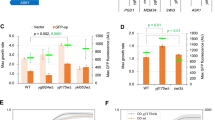Abstract
THE acidic transcriptional activation motif functions in all eukary-otes1–4, which suggests that it makes contact with some universal component of the transcriptional apparatus. Transcriptional activation by the yeast regulatory protein GAL4 requires an acidic region at its carboxyl terminus. Here we implement a selection scheme to determine whether GAL4 can still function when this C-terminal domain has been deleted. It can, when accompanied by a mutation in the SUG1gene which is an essential gene in yeast. Analysis of mutant SUG1in combination with various alleles of GAL4 indicates that SUG1 acts through a transcriptional pathway that depends on GAL4, but requires a region of GAL4 other than the C-terminal acidic activation domain. The predicted amino-acid sequence of SUG1 closely resembles that of two human proteins, TBP1 and MSS1, which modulate expression mediated by the human immunodeficiency virus tatgene.
This is a preview of subscription content, access via your institution
Access options
Subscribe to this journal
Receive 51 print issues and online access
$199.00 per year
only $3.90 per issue
Buy this article
- Purchase on Springer Link
- Instant access to full article PDF
Prices may be subject to local taxes which are calculated during checkout
Similar content being viewed by others
References
Fischer, J. A., Giniger, E., Maniatis, T. & Ptashne, M. Nature 332, 853–856 (1988).
Ma, J., Przbilla, E., Hu, J., Bogorad, L. & Ptashne, M. Nature 334, 631–633 (1988).
Kakidani, H. & Ptashne, M. Cell 52, 161–167 (1988).
Webster, N., Jin, J. R., Green, S., Hollis, M. & Chambon, p. Cell 52, 169–178 (1988).
Matsumoto, K., Adachi, Y., Toh-E, A. & Oshima, Y. J. Bact. 141, 508–527 (1980).
Himmelfarb, H. J., Pearberg, J., Last, D. H. & Ptashne, M. Cell 63, 1299–1309 (1990).
Suzuki, Y., Nogi, Y., Abe, A. & Fukasawa, T. Molec. cell. Biol. 8, 4991–4999 (1988).
Nishizawa, M., Suzuki, Y., Nogi, Y., Matsumoto, K. & Fukasawa, T. Proc. natn. Acad. Sci. U.S.A. 87, 5373–5377 (1990).
Johnston, M. & Dover, J. Genetics 120, 63–74 (1988).
Gill, G. & Ptashne, M. Cell 51, 121–126 (1987).
Salmeron, J. M. & Johnston, S. A. Nucleic Acid Res. 14, 7767–7781 (1986).
Mylin, L. M., Johnston, M. & Hopper, J. E. Molec. cell. Biol. 10, 4623–4629 (1990).
Erdmann, R. et al. Cell 64, 499–510 (1991).
Nelbock, P., Dillon, P. J., Perkins, A. & Rosen, C. Science 248, 1650–1653 (1990).
Eakle, K. A., Bernstein, M. & Emr, S. D. Molec. cell. Biol. 8, 4098–4109 (1988).
Block, M. R., Glick, B. S., Wilcox, D. E., Wieland, F. T. & Rothman, J. E. Proc. natn. Acad. Sci. U.S.A. 86, 7582–7586 (1988).
Fröhlich, K.-U. et al. J. Cell Biol. 114, 443–453 (1991).
Koller, K. J. & Brownstein, M. J. Nature 325, 542–545 (1987).
Peters, J.-M., Walsh, M. J. & Franke, W. W. EMBO J. 9, 1757–1767 (1990).
Author information
Authors and Affiliations
Rights and permissions
About this article
Cite this article
Swaffield, J., Bromberg, J. & Johnston, S. Alterations in a yeast protein resembling HIV Tat-binding protein relieve requirement for an acidic activation domain in GAL4. Nature 357, 698–700 (1992). https://doi.org/10.1038/357698a0
Received:
Accepted:
Issue Date:
DOI: https://doi.org/10.1038/357698a0
This article is cited by
-
PSMC5 regulates microglial polarization and activation in LPS-induced cognitive deficits and motor impairments by interacting with TLR4
Journal of Neuroinflammation (2023)
-
How the ubiquitin–proteasome system controls transcription
Nature Reviews Molecular Cell Biology (2003)
-
Localisation of 26S proteasomes with different subunit composition in insect muscles undergoing programmed cell death
Cell Death & Differentiation (2000)
-
Identification of the gal4 suppressor Sug1 as a subunit of the yeast 26S proteasome
Nature (1996)
-
Interaction of thyroid-hormone receptor with a conserved transcriptional mediator
Nature (1995)
Comments
By submitting a comment you agree to abide by our Terms and Community Guidelines. If you find something abusive or that does not comply with our terms or guidelines please flag it as inappropriate.



